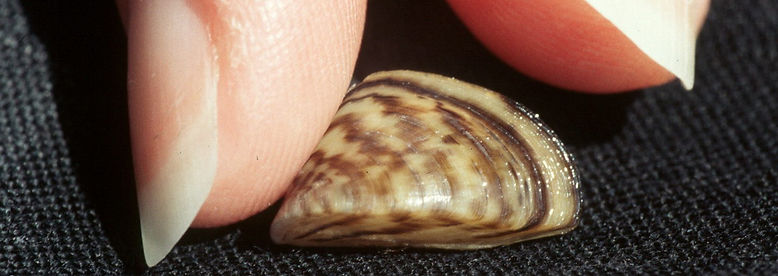

Newsletters
Am I allowed to use the login credentials of
another person to access the database?
Alligatorweed
(Alternanthera philoxeroides)
Found an invasive species? Register for a free login account, or submit a public report.

Zebra Mussel
Photo credit: Amy Benson, U.S. Geological Survey, Bugwood.org
(Dreissena polymorpha)
Report this Species!
If you believe you have found this species anywhere in Pennsylvania, please report your findings to iMapInvasives by submitting an observation record.
-
Already a registered user? Login to submit your observation.
-
Not a registered user? Submit a public report.
-
Watch our training video to learn how to submit an observation record (as a registered user).
Species at a Glance
The zebra mussel is a small, fingernail-sized, freshwater mollusk that attaches to hard objects and costs billions of dollars to control and remove. Since its discovery in the Great Lakes, it has quickly spread to become one of the most intrusive, prolific, and costly aquatic invaders in North America. In many open-water environments, they can be virtually impossible to eradicate once established.
Identification
Although the zebra mussel is named for the alternating light and dark bands present on the shell, color patterns can vary between black, brown, beige, and tan, with white to yellow stripes or zigzagged patterns. The shell is triangular or “D”-shaped, with a straight midventral line and a prominent ridge on each valve that allows the mussel to sit upright on its ventral margin. While size is typically 2-2.5 cm (0.8-1 in) in length, some mussels can reach up to 5 cm (2 in). The sticky, thread-like projections, called byssal threads, are located toward the middle of the shell and help it attach to hard substrates. Eggs develop into round, microscopic larvae called veligers that free-float in the water column for up to five weeks before settling. Under polarized light, veligers appear to be marked with a dark “X”.
Similar Species
A close relative, the quagga mussel (Dreissena bugensis) is also fingernail-sized but more rounded or fan-shaped, lacking the prominent ridges and flat ventral margin that allow the zebra mussel to sit upright. A quagga mussel would simply topple over if placed on its ventral margin. Also, the midventral line of the quagga mussel is curved, and the byssal threads are located toward the anterior end of the shell.
Habitat
The zebra mussel can be found in lakes, rivers, reservoirs, ponds, and quarries. It requires enough calcium for shell production, and water temperatures over 10°C (50°F) for reproduction. It can be found attached to hard surfaces such as rocks, wood, concrete, steel, and even other organisms like native mussels and crayfish.
Spread
One female zebra mussel can produce up to one million eggs in a breeding season. The free-floating veligers can be scooped up undetected and transferred in bait buckets, bilge water, and live wells. Because it can survive out of water for up to five days, this mussel is easily transported to other waterways on recreational boating, fishing, and diving gear.
Distribution
While native to the Black, Azov, and Caspian sea drainages, the zebra mussel first appeared in the Great Lakes in Lake St. Clair in 1988, probably imported in contaminated ballast water. It has since spread throughout all of the Great Lakes, the Mississippi River drainage, and many inland lakes. In the Mid-Atlantic region, zebra mussels are established in Maryland, New York, Pennsylvania, and West Virginia.
Note: Distribution data for this species may have changed since the publication of the Mid-Atlantic Field Guide to Aquatic Invasive Species (2016), the source of information for this description.
Environmental Impacts
The clustering behavior of the zebra mussel causes it to clog water intake pipes and damage equipment at power and water facilities, making it very expensive to remove and control. It also harms fisheries, alters water quality, and increases the growth of harmful algae. It decreases food sources for native species by filtering large amounts of microscopic plants and animals from the water, and it accumulates contaminants in its fatty tissues. The economic impact of zebra and quagga mussels in the U.S. is estimated in the billions of dollars.
Videos
Note
Information for this species profile comes from the Mid-Atlantic Field Guide to Aquatic Invasive Species (2016).